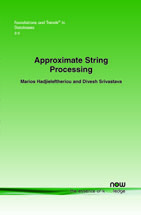Approximate String Processing
By Marios Hadjieleftheriou, AT&T Labs - Research, USA, marioh@research.att.com | Divesh Srivastava, AT&T Labs - Research, USA, divesh@research.att.com
Abstract
One of the most important primitive data types in modern data processing is text. Text data are known to have a variety of inconsistencies (e.g., spelling mistakes and representational variations). For that reason, there exists a large body of literature related to approximate processing of text. This monograph focuses specifically on the problem of approximate string matching, where, given a set of strings S and a query string υ, the goal is to find all strings s ε S that have a user specified degree of similarity to υ. Set S could be, for example, a corpus of documents, a set of web pages, or an attribute of a relational table. The similarity between strings is always defined with respect to a similarity function that is chosen based on the characteristics of the data and application at hand. This work presents a survey of indexing techniques and algorithms specifically designed for approximate string matching. We concentrate on inverted indexes, filtering techniques, and tree data structures that can be used to evaluate a variety of set based and edit based similarity functions. We focus on all-match and top-k flavors of selection and join queries, and discuss the applicability, advantages and disadvantages of each technique for every query type.
Approximate String Processing
One of the most important primitive data types in modern data processing is text. Text data are known to have a variety of inconsistencies (e.g., spelling mistakes and representational variations). For that reason, there exists a large body of literature related to approximate processing of text.
Approximate String Processing focuses specifically on the problem of approximate string matching and surveys indexing techniques and algorithms specifically designed for this purpose. It concentrates on inverted indexes, filtering techniques, and tree data structures that can be used to evaluate a variety of set based and edit based similarity functions. The focus is on all-match and top-k flavors of selection and join queries, and it discusses the applicability, advantages and disadvantages of each technique for every query type.
Approximate String Processing is organized into nine chapters. Sandwiched between the Introduction and Conclusion, Chapters 2 to 5 discuss in detail the fundamental primitives that characterize any approximate string matching indexing technique. The next three chapters, 6 to 9, are dedicated to specialized indexing techniques and algorithms for approximate string matching.
